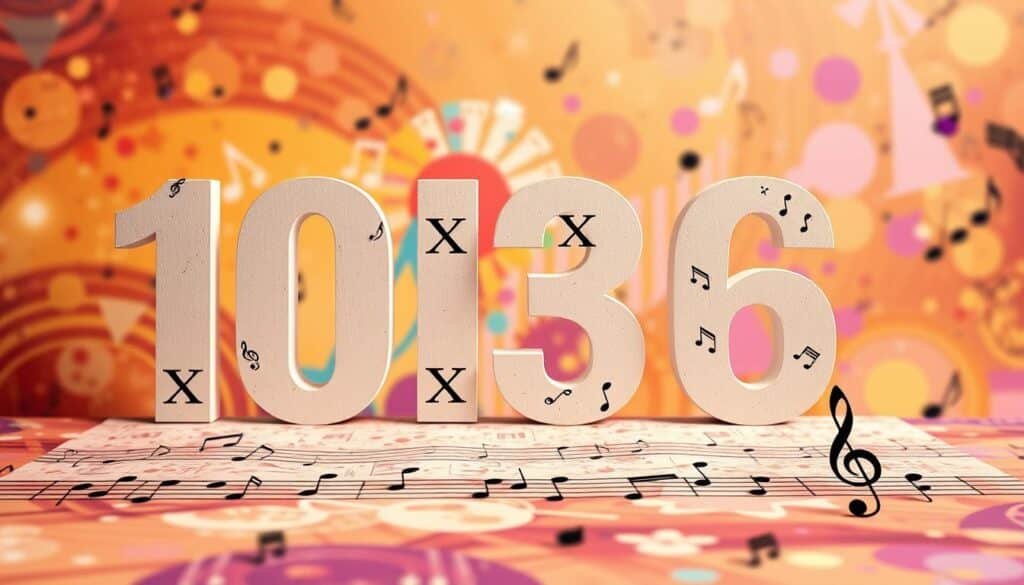Contemporary pop music is like a beautiful tapestry, filled with complex melodies and catchy chord progressions. We often get caught up in the catchy rhythms and hooks of pop music. But, the real magic happens with its harmonic elements. This article looks at how harmony shapes modern pop music. It explores common harmonic patterns, chord progressions, and variations that make pop music special.
Also Read: The Impact Of Classical Music On Cognitive Development
Key Takeaways
- Harmony is a key part of what makes contemporary pop music sound the way it does.
- Many popular songs use common harmonic progressions and schemas.
- Learning about harmony basics like consonance, dissonance, and intervals helps us understand how pop music is made.
- Using Roman numerals and functional harmony analysis reveals the harmonic structure of classic pop songs.
- Studying the harmonic elements of pop music helps us appreciate the creativity in the genre more deeply.
Understanding Harmonic Schemas in Pop Music
Pop music is built on certain harmonic schemas or chord progressions. These patterns help create the catchy tunes and stories in songs. They give pop composers a solid base to work with.
Also Read: How To Write Music?
Common Harmonic Progressions
Some common harmonic schemas in pop are the 12-bar blues, the plagal progression, the double plagal, and the circle-of-fifths pattern. These patterns are well-known and help artists make their songs catchy. They add a familiar touch while allowing for new twists.
Variations and Deviations from Prototypes
Pop composers often add their own touch to these patterns. They use chromatic notes, chord inversions, and other techniques. This makes the music unique and interesting. By changing the harmonic variations in pop music, artists keep the songs fresh and exciting.
The use of pop music chord progressions in hits and experimental chord progressions in pop shows how important harmony is in pop. Harmony makes pop music rich and ever-changing, reflecting the genre’s dynamic nature.
“Harmony is the heart and soul of pop music, providing the canvas upon which the melodies and lyrics come to life.”
Also Read: Top Benefits Of Music Education For Kids: Why Every Child Should Learn Music
The Fundamentals of Harmony

To understand pop music, we must grasp the basics of music theory fundamentals. Harmony is built on the balance between consonance and dissonance. These terms describe how notes sound together. They help pop composers craft their sound.
Consonance and Dissonance
Consonance means sounds that blend well together. Dissonance means sounds that clash. The feeling of consonance or dissonance comes from the intervals between notes. Perfect fifths and major thirds sound good together, while minor seconds and major sevenths don’t.
Also Read: Top Music Streaming Services Of 2024: Which One Is Right For You?
Musical Intervals and Chord Building
Knowing about musical intervals helps us make chords. Chords have three notes, each a third apart. Pop writers use these to make complex chords like seventh chords, adding depth to their songs.
“The foundation of all music is harmony, and the foundation of harmony is the triad.”
– Arnold Schoenberg
Learning about music theory fundamentals like consonance and chord building opens up creativity. It lets pop musicians shape their sound and engage listeners.
Roman Numerals and Functional Harmony

Learning about roman numerals in music theory is key to understanding functional harmony in pop music today. This method helps us see how composers use chords to create tension and release. They use the tonic, pre-dominant, and dominant chord functions for this.
Also Read: Music Theory Basics: A Beginner’s Guide To Understanding Music
Roman numerals label the scale degrees of chords in a key. Chords get a number from I to VII based on their spot in relation to the tonic. For instance, the tonic chord is I, the subdominant is IV, and the dominant is V. Knowing these functional roles helps musicians grasp the song’s harmonic structure and its emotional effect.
| Scale Degree | Roman Numeral | Functional Role |
|---|---|---|
| 1st | I | Tonic |
| 4th | IV | Subdominant |
| 5th | V | Dominant |
Looking at pop music with functional harmony and roman numerals gives us deeper insights. We see how artists craft songs that touch our feelings. This knowledge makes us appreciate pop music more and its lasting charm.
“The use of roman numerals in music theory provides a powerful tool for understanding the underlying structure and emotional impact of pop music compositions.”
Pop Music Chord Progressions

Let’s dive into the world of pop music chord progressions. These structures are key to the genre, creating catchy tunes that fans love. By looking at pop music chord progressions, we can see what makes these songs so catchy.
Diatonic Triads and Functions
Pop music’s core is the diatonic triads, the harmony basics. These triads, with three notes in a key, have special chord functions. The tonic, pre-dominant, and dominant chords create tension and resolution. This keeps the song moving and makes it enjoyable.
Analyzing Classic Pop Progressions
Let’s look at famous pop music chord progressions. The “50’s progression” uses a I-vi-IV-V sequence and is found in many hits. It shows how diatonic triads and chord functions work together to make great music. By studying these progressions, we learn what makes pop music tick.
| Chord Progression | Chord Functions | Example Songs |
|---|---|---|
| I-vi-IV-V | Tonic, Pre-Dominant, Dominant | “Stand By Me” by Ben E. King, “Sweet Caroline” by Neil Diamond |
| I-V-vi-IV | Tonic, Dominant, Relative Minor, Pre-Dominant | “Don’t Stop Believin'” by Journey, “Despacito” by Luis Fonsi and Daddy Yankee |
| ii-V-I | Pre-Dominant, Dominant, Tonic | “Smooth” by Santana ft. Rob Thomas, “Can’t Help Falling in Love” by Elvis Presley |
Also Read: How Did These Strange Songs Hit?
Conclusion
This article has shown how pop music harmony is key to the sound of today’s pop music. We’ve looked at common harmonic schemas, chord-building, and functional harmony. This helps us see how pop composers make their catchy tunes and chord progressions.
By exploring the role of harmony in pop music, we’ve learned a lot. This knowledge is great for musicians and producers who want to improve their skills. It helps them make music that sounds good and appeals to listeners.
We’ve seen why understanding pop music theory is important. It lets artists and producers create better music. This way, their music can reach more people and do well in the market.
FAQs
Q: What is the role of harmony in the pop music genre?
A: Harmony plays a crucial role in the pop music genre by creating a rich sound that enhances melodies and makes songs more accessible to listeners, allowing them to connect emotionally with the music.
Q: How have pop artists like Taylor Swift and Madonna utilized harmony in their music?
A: Artists like Taylor Swift and Madonna have effectively utilized harmony by integrating complex chord progressions and vocal harmonies, which contribute to their distinct sound and help their singles become popular on radio and streaming platforms.
Q: What are some of the characteristics that define pop music as a genre?
A: Pop music is a genre characterized by catchy melodies, simple lyrics, and repetitive structures, often featuring harmonies that make the music accessible and appealing to a wide audience, helping it to trend on platforms like YouTube and Billboard.
Q: How can harmony impact the mainstream success of a pop song?
A: The use of effective harmonic structures can significantly impact the mainstream success of a pop song, as they can enhance emotional expression and memorability, making a track more likely to feature on pop playlists and become a hit.
Q: What are some examples of the best pop songs that showcase harmony?
A: Examples of the best pop songs that showcase harmony include “Billie Jean” by Michael Jackson and “Like a Prayer” by Madonna, both of which feature intricate harmonies that contribute to their lasting popularity in pop culture.
Q: How does harmony differ between pop music and other genres like classical or jazz?
A: Harmony in pop music typically focuses on simplicity and accessibility, while in classical and jazz, it often involves more complex structures and progressions, which can challenge listeners and create a different listening experience.
Q: How do emerging pop artists incorporate harmony in their new pop music?
A: Emerging pop artists often incorporate harmony in their new pop music by blending various influences, including R&B and electronic elements, to create unique harmonies that resonate with a younger audience and reflect current trends.
Q: Why is understanding harmony important for musicians and songwriters in the pop genre?
A: Understanding harmony is vital for musicians and songwriters in the pop genre as it allows them to craft more compelling songs that appeal to listeners’ tastes, ultimately helping them to become popular and secure a place in the competitive music industry.
Q: What trends in pop music harmony can we expect to see in 2024?
A: In 2024, we can expect to see trends in pop music harmony that feature more experimental sounds, blending genres like indie and hip hop, along with a focus on vocal layering and harmonization that enhances the emotional impact of the music.




